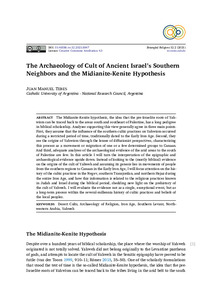Por favor, use este identificador para citar o enlazar este ítem:
https://repositorio.uca.edu.ar/handle/123456789/11373| Campo DC | Valor | Lengua/Idioma |
|---|---|---|
| dc.contributor.author | Tebes, Juan Manuel | es |
| dc.date.accessioned | 2021-04-08T12:19:19Z | - |
| dc.date.available | 2021-04-08T12:19:19Z | - |
| dc.date.issued | 2021 | - |
| dc.identifier.citation | Tebes, J. M. The archaeology of cult of ancient Israel’s southern neighbors and the midianite-kenite hypothesis [en línea]. Entangled Religions. 2021, 12(2) Doi: 10.46586/er.12.2021.8847. Disponible en: https://repositorio.uca.edu.ar/handle/123456789/11373 | es |
| dc.identifier.issn | 2363-6696 (en línea) | - |
| dc.identifier.uri | https://repositorio.uca.edu.ar/handle/123456789/11373 | - |
| dc.description.abstract | Abstract: The Midianite-Kenite hypothesis, the idea that the pre-Israelite roots of Yahwism can be traced back to the areas south and southeast of Palestine, has a long pedigree in biblical scholarship. Analyses supporting this view generally agree in three main points. First, they assume that the influence of the southern cultic practices on Yahwism occurred during a restricted period of time, traditionally dated to the Early Iron Age. Second, they see the origins of Yahwism through the lenses of diffusionist perspectives, characterizing this process as a movement or migration of one or a few determined groups to Canaan. And third, adequate analyses of the archaeological evidence of the arid areas to the south of Palestine are few. In this article I will turn the interpretation of the epigraphic and archaeological evidence upside down. | es |
| dc.format | application/pdf | es |
| dc.language.iso | eng | es |
| dc.publisher | Ruhr-Universität Bochum | es |
| dc.relation | Elites, circuitos económicos y sistemas de creencias en el Levante, Mesopotamia y el Mediterráneo Oriental | es |
| dc.rights | Acceso abierto | * |
| dc.rights.uri | http://creativecommons.org/licenses/by-nc-sa/4.0/ | * |
| dc.source | Entangled Religions, 2021, 12(2) | es |
| dc.subject | ARQUEOLOGIA BIBLICA | es |
| dc.subject | EDAD DE HIERRO | es |
| dc.subject | HISTORIA ANTIGUA | es |
| dc.title | The archaeology of cult of ancient Israel’s southern neighbors and the midianite-kenite hypothesis | es |
| dc.type | Artículo | es |
| dc.identifier.doi | 10.46586/er.12.2021.8847 | - |
| uca.disciplina | HISTORIA | es |
| uca.issnrd | 1 | es |
| uca.affiliation | Fil: Tebes, Juan Manuel. Pontificia Universidad Católica Argentina; Argentina | es |
| uca.affiliation | Fil: Tebes, Juan Manuel. Consejo Nacional de Investigaciones Científicas y Técnicas; Argentina | es |
| uca.version | publishedVersion | es |
| item.fulltext | With Fulltext | - |
| item.grantfulltext | open | - |
| item.languageiso639-1 | en | - |
| crisitem.author.dept | Facultad de Ciencias Sociales | - |
| crisitem.author.dept | Instituto de Investigaciones de la Facultad de Ciencias Sociales (IICS) | - |
| crisitem.author.dept | Consejo Nacional de Investigaciones Científicas y Técnicas | - |
| crisitem.author.dept | Centro de Estudios de Historia del Antiguo Oriente (CEHAO) | - |
| crisitem.author.dept | Programa de Estudios de las Sociedades Premodernas (PESPREM) | - |
| crisitem.author.orcid | 0000-0002-9623-3380 | - |
| crisitem.author.parentorg | Pontificia Universidad Católica Argentina | - |
| crisitem.author.parentorg | Facultad de Ciencias Sociales | - |
| crisitem.author.parentorg | Departamento de Historia | - |
| crisitem.author.parentorg | Instituto de Investigaciones de la Facultad de Ciencias Sociales (IICS) | - |
| Aparece en las colecciones: | Artículos | |
Ficheros en este ítem:
| Fichero | Descripción | Tamaño | Formato | |
|---|---|---|---|---|
| archaeology-cult-ancient-israel.pdf | 18,26 MB | Adobe PDF |  Visualizar/Abrir |
Visualizaciones de página(s)
191
comprobado en 30-abr-2024
Descarga(s)
1.331
comprobado en 30-abr-2024
Google ScholarTM
Ver en Google Scholar
Altmetric
Altmetric
Este ítem está sujeto a una Licencia Creative Commons

